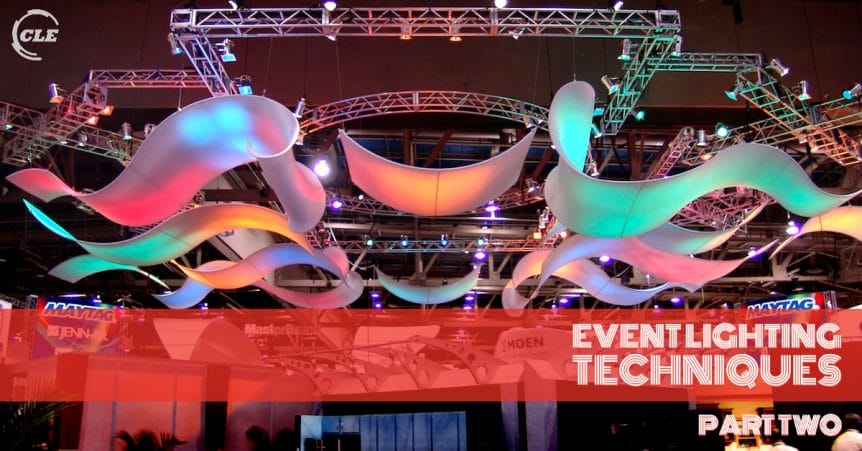(Part Two of Series) Read An Introduction to Event Lighting Techniques, Part 1
Event lighting techniques have the power to evoke emotion, compliment décor, and kick up the fun to create unique events. It can be transformational for event productions. Using lighting and color to tie together your theme and logo colors throughout the event (from registration arrival through exhibit areas and meeting rooms) is key to the overall attendee experience. Visual continuation is an impactful way to accomplish the goal of reinforcing your theme and message. Beyond making sure your audience can see the presenters, event lighting has versatile applications for your events.
Event Lighting Techniques for Registration
A registration area could have lighting that ties into the pre-function reception that flows into the main event room. For example, if your theme is “Pillars of Success,” and your scenic design on stage includes pillars with blue lighting. Adding a couple of blue lighted pillars at registration can be eye-catching and begin to set the mood as attendees arrive and are waiting to check-in.
Uplighting
LED uplights can be used to add a colorful glow to draping, backdrops, walls, pillars, or just about anything you want to highlight. Colorful LED lights produce an impactful look while incorporating theme or logo colors. The uplights don’t always have to be positioned straight up. Angling light fixtures or making them asymmetrical will create a more interesting, exciting, and unique look.
Intelligent Lights
Intelligent lights often referred to as moving lights, provide movement, and textured light patterns that add depth and dimension to stage sets, backdrops, ceiling décor, dancefloors, and the list goes on. Apply lighting techniques with movement to build excitement and engage your audience. Adding a haze or fog machine allows you to see the beams and texture of the light, creating a more dramatic look. If you want to use fog or haze, make sure to check the rules on using these machines with your venue event manager.
Layered Lighting
Layered lighting techniques create both impact and a stunning atmosphere. One example would be to flood a wall or ceiling with purple lighting and project a pattern over the color. Or in a tent, you could design a warm glow of illumination between the tent and fabric liner and hang café lights or project patterned lighting to add to the ambiance.
A lighting console is used to program lights and can design several different lightings looks for a single area. For example, when designing a walk-in look with moving lights, bright colors create a fun and engaging experience to start your meeting. As your program progresses, you would design a transition to the lighting look that would include less movement and possibly use logo or theme colors. For an evening program, social event, or fashion show, you might choose an entirely different look by just changing the lighting colors and patterns. The options are almost infinite.
Carefully Define Event Lighting Goals
Knowing what you want your event to feel like and areas you wish to include will get you on the right path as you work with your technology partner to design a lighting solution for your next event.
To learn more about CLE’s event lighting and see more photos, browse our Gallery or visit our Facebook page. Make event lighting part of your Event Planning Checklist!
Keep learning. View our Lighting Glossary of Terms.
Read An Introduction to Event Lighting Techniques, Part 1
Share this Post

